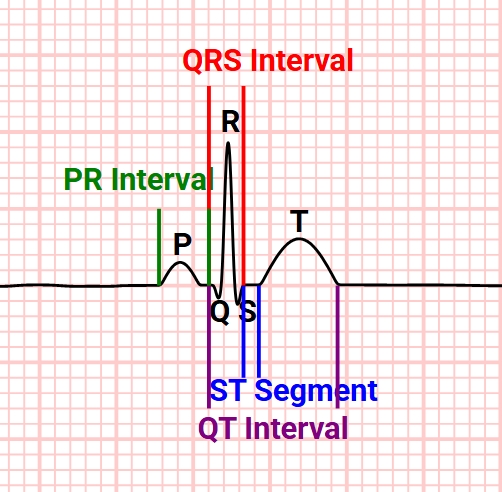Free EKG Simulator & ECG Simulator
Rhythm Description
EKG Learning GuideEKG Basics
An EKG (electrocardiogram) records the electrical activity of the heart over a period of time. Here are some important measurements:
- Normal QRS duration: 0.08 to 0.10 seconds
- PR interval: 0.12 to 0.20 seconds
- QT interval: 0.35 to 0.45 seconds
- Standard grid measurements: Each small box represents 0.04 seconds horizontally and 0.1 mV vertically.
Grid Details
The EKG grid is composed of small and large boxes:

- Small box: 0.04 seconds (40 ms) horizontally and 0.1 mV vertically.
- Large box: 0.20 seconds (200 ms) horizontally and 0.5 mV vertically.
Understanding Intervals and Segments
- P wave: Represents atrial depolarization. Duration: up to 0.12 seconds.
- PR interval: Time from the onset of atrial depolarization to the onset of ventricular depolarization. Duration: 0.12 to 0.20 seconds.
- QRS complex: Represents ventricular depolarization. Normal duration: 0.08 to 0.10 seconds. A duration longer than 0.12 seconds may indicate a bundle branch block or other conduction delay.
- ST segment: The flat, isoelectric section of the EKG between the end of the S wave and the start of the T wave. It represents the interval between ventricular depolarization and repolarization.
- T wave: Represents ventricular repolarization. The shape and duration of the T wave can provide important information about electrolyte imbalances, ischemia, and other conditions.
- QT interval: Time from the beginning of the QRS complex to the end of the T wave, representing the total time for ventricular depolarization and repolarization. Duration: 0.35 to 0.45 seconds.
Clinical Significance
- Prolonged QT interval can predispose to ventricular arrhythmias like Torsades de Pointes.
- Shortened PR interval may indicate pre-excitation syndromes like Wolff-Parkinson-White (WPW) syndrome.
- Elevated ST segment can be a sign of myocardial infarction (heart attack).
- Depressed ST segment may indicate ischemia or strain.
Quiz on the Selected Rhythm
💙 Support Our Free Content
Your support helps us continue creating free nursing content. Explore our Nursing Essentials page to see our recommended tools and resources.
🛍️ View Nursing Essentials